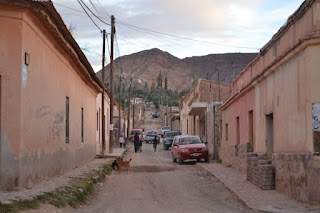Dia 3 : Morning in the Cafayate bodegas
I always knew they was something holy around me....for sure this day that was the Torrontes vineyards, the only white genuine argentine wine and probably the most famous. Fruity, highly alcoholic and let s say really nice for your thirsty mouth or to accompany the local truit served on the peacefull Plaza central.
Other alternative is a red Tannat, sweeter and softer than a Malbec. The one from bodega El Estaco (Michel Torino) is well done. Petra appreciates.
Cafayate is smaller, cooler and more pitoresque than the great Mendoza city. So no worth to reserve for a wine degustation or spend one hour by car, just go as all bodegas are btw 5 and 10 mn from downtown. The tiny "bodega de las nubes" is beneath a red coloured rocky mountain and offers a splendid panorama on the Quebrada. For sure a wine degustation at 10am seems tricky but the result is a big smile for both.
A view from the bigger bodega El Estaco, shot from the top of their renovated tower
Dia 3: Afternoon and the start of the great Ruta 40
Ruta 40 is one of the most famous road in the world as it offers splendid and diverse views along the Andes, starting close to Bolivia on the North side, going through deserts, rios, pampas, valleys, mountains until the South of Patagonia and the Tierra de Fuegos. Che Guevarra popularized it discovering his country on his moto. In fact a 4x4 is more than necessary as main of the road is not paved and you re constantly crossing rivers...it is the reason why we used the Chevy below to add some salt to this roadtrip ! On est des fous
You cross some lost villages, you really think you are in a videogame, as though angry zombies would surge from behind the church!!
!!!Look at the ugly one below the tyre!!!I told you
Gomeria means car garage, it is a long time the last tractor visited this one
Cactus is more abundant than wood, locals use it to build furnitures : chairs, tables, beds or to indicate an old chappel from the 18th century
This is the chappel, surrounded by an amazing decorum and a big river on the below
After 100km of dusty, rocky paths and baking sun it seems you re having some hallucinations and make out some nymphs. These 100km need merely 4 hours drive but definitely worth it, maybe our favorite time in the region.
To have some rest we ve decided to sleep in Molinos, another lost village but with real people and probably the most romantic and authentic place in the valley.
With maybe 300 inhabitants, Molinos has been founded by the Spanish, it was managed by a "gobernator" who had nearly 4000 indians working for him













































